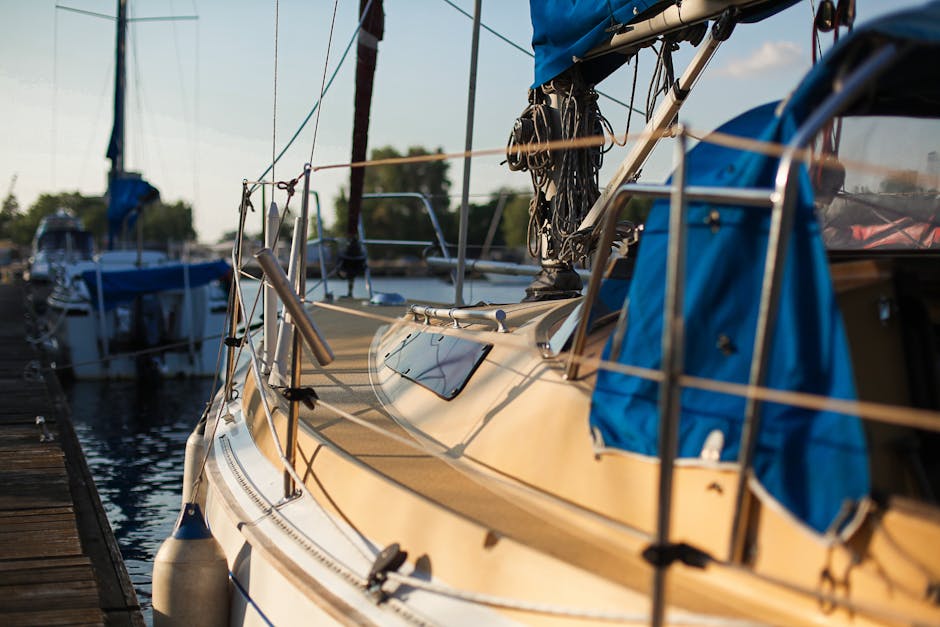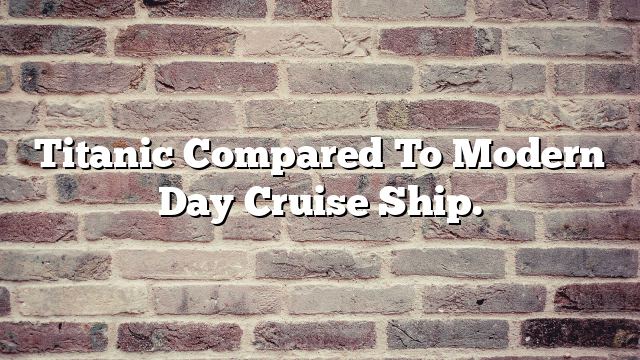The Titanic, often hailed as the “unsinkable” ship, has captivated the imaginations of people worldwide for over a century. Its tragic maiden voyage in 1912, resulting in the loss of over 1,500 lives, is a story of hubris, bravery, and the relentless power of the sea. Today, as we step aboard modern cruise ships, it is only natural to wonder how the Titanic would stack up against these technological marvels of the 21st century. In this exploration, we will delve into the stark differences between the Titanic and modern-day cruise ships, examining advancements in safety measures, size, amenities, and overall design. Prepare to embark on a journey that will transport you from the past to the present, as we compare the grandeur and innovation of the Titanic to our contemporary floating palaces.
The Titanic was a marvel of its time, a symbol of human progress and opulence. With its luxurious cabins, exquisite dining halls, and state-of-the-art amenities, it was a floating palace that catered to the elite. However, beneath its grand facade lurked a fatal flaw – an insufficient number of lifeboats to accommodate all the passengers and crew. As we fast forward to the present day, modern cruise ships have made tremendous strides in prioritizing passenger safety. From the implementation of advanced navigation systems to the incorporation of rigorous safety drills, today’s cruise ships have become fortresses on the water, designed to mitigate the risks that plagued the Titanic. Join us as we dive into the fascinating evolution of these majestic vessels, and discover how modern cruise ships have revolutionized the way we sail the high seas.
Titanic compared to modern day cruise ship:
The Titanic, a historic ship that sank in 1912, was significantly smaller and less technologically advanced than modern day cruise ships. While the Titanic had a length of about 882 feet, modern cruise ships can exceed 1,000 feet. Additionally, cruise ships today boast advanced safety features, luxurious amenities, and can accommodate thousands of passengers, whereas the Titanic had limited safety measures and amenities for its time.

Titanic Compared to Modern Day Cruise Ship
The Titanic, a renowned historical symbol of tragedy and grandeur, has long captivated the imagination of people worldwide. In this article, we will explore the differences between the Titanic and modern-day cruise ships, highlighting the advancements and innovations that have revolutionized the cruise industry.
1. Size and Capacity
One of the most obvious disparities between the Titanic and modern-day cruise ships is their size and capacity. The Titanic, built in the early 20th century, was considered the largest and most luxurious ship of its time. With a length of approximately 882 feet and a gross tonnage of around 46,000, it could accommodate around 2,435 passengers and 892 crew members.
On the other hand, modern-day cruise ships have far surpassed the Titanic in terms of size and capacity. Some of the largest cruise ships today measure over 1,100 feet in length and can carry well over 6,000 passengers, along with thousands of crew members. These impressive numbers reflect the significant growth and expansion of the cruise industry over the past century.
2. Safety Measures
Another crucial aspect to consider when comparing the Titanic to modern-day cruise ships is the advancements in safety measures. The Titanic, despite being deemed unsinkable, tragically sank on its maiden voyage in 1912. The lack of adequate safety features and equipment, such as enough lifeboats for all passengers, contributed to the high loss of life.
Modern-day cruise ships, however, prioritize passenger safety as a top priority. Stringent regulations and international maritime standards require ships to have more than enough lifeboats and life rafts to accommodate all passengers and crew members. Additionally, advanced navigation systems, modern communication devices, and comprehensive emergency response protocols ensure a higher level of safety and security on board.
3. Onboard Amenities
The onboard amenities available on the Titanic were considered luxurious for its time, featuring a swimming pool, gymnasium, Turkish bath, and even a squash court. However, when compared to the modern-day cruise ships, the offerings on the Titanic seem relatively basic.
Modern cruise ships are like floating resorts, equipped with an extensive array of amenities and entertainment options. From multiple swimming pools, water slides, rock climbing walls, and mini golf courses to theaters, casinos, spas, and even ice skating rinks, the range of activities available on modern cruise ships is truly remarkable. These amenities ensure that passengers have an unforgettable and enjoyable experience during their voyage.
4. Technology and Innovation
The technological advancements in the cruise industry over the past century are staggering. The Titanic relied on coal-powered engines and basic communication systems, whereas modern-day cruise ships utilize state-of-the-art propulsion systems, including diesel-electric and even liquefied natural gas (LNG) engines, making them more environmentally friendly and efficient.
Furthermore, modern cruise ships are equipped with cutting-edge technology, such as stabilizers to minimize motion sickness, satellite communication for uninterrupted connectivity, and sophisticated navigation systems for precise and safe sailing. These advancements in technology have greatly enhanced the overall cruising experience for passengers.
5. Environmental Considerations
The Titanic, being a product of its time, was not designed with environmental considerations in mind. The ship’s engines emitted large amounts of smoke, and waste disposal practices were far from sustainable. In contrast, modern cruise ships are built with a strong focus on environmental sustainability.
Today’s cruise ships are equipped with advanced wastewater treatment systems, energy-efficient engines, and recycling programs to minimize their impact on the environment. Additionally, many cruise lines have implemented sustainable practices, such as reducing single-use plastics and supporting conservation initiatives, to ensure responsible cruising.
Frequently Asked Questions
Welcome to our FAQ section where we answer common questions about the Titanic compared to modern-day cruise ships.
What were the main differences in size between the Titanic and modern-day cruise ships?
The Titanic, when it was built in 1912, was the largest ship in the world at that time. It had a length of 882 feet and a maximum width of 92 feet. In comparison, modern-day cruise ships can be much larger. For instance, the Symphony of the Seas, which is currently the largest cruise ship, has a length of 1,188 feet and a maximum width of 215 feet. This significant increase in size allows modern cruise ships to accommodate more passengers and provide a wider range of amenities and facilities.
Furthermore, modern cruise ships also have a greater number of decks compared to the Titanic. The Titanic had nine decks, while modern ships can have as many as 18 decks or more. This allows for more cabin options, dining venues, entertainment areas, and recreational facilities on board.
How do the safety features of the Titanic differ from those of modern-day cruise ships?
One of the most notable differences between the Titanic and modern-day cruise ships is the approach to safety. The Titanic had a limited number of lifeboats, which proved to be insufficient for all the passengers and crew on board. This tragic event led to significant changes in maritime safety regulations.
Modern cruise ships, on the other hand, are equipped with a sufficient number of lifeboats and life rafts to accommodate all passengers and crew. In addition, they have advanced safety systems, including state-of-the-art navigation equipment, fire detection and suppression systems, and strict emergency response protocols. These safety measures are continuously updated and improved to ensure the well-being of everyone on board.
What were the dining options like on the Titanic compared to modern-day cruise ships?
The Titanic offered several dining options, including a grand dining room, a cafe Parisien, and an à la carte restaurant. The first-class passengers enjoyed luxurious meals with a variety of choices, while the second and third-class passengers had more limited options. Meals were served in a traditional, formal style.
In contrast, modern-day cruise ships provide a wide range of dining options to cater to different tastes and preferences. Passengers can choose from multiple restaurants offering various cuisines, including specialty restaurants, casual buffet-style dining, and even 24-hour room service. Furthermore, many ships offer flexible dining arrangements, allowing passengers to dine at their convenience rather than adhering to set meal times.
How did the accommodations on the Titanic differ from those on modern-day cruise ships?
The Titanic had different classes of accommodations, with first-class passengers enjoying luxurious cabins with private bathrooms and more spacious living areas. Second and third-class passengers had more modest accommodations, often with shared facilities.
Modern cruise ships offer a wide range of cabin options, ranging from small interior cabins to lavish suites with private balconies. Most cabins now come with en-suite bathrooms, and many offer additional amenities such as flat-screen TVs, mini-fridges, and even private butlers in some cases. The overall standard of accommodations on modern-day cruise ships has significantly improved to provide maximum comfort and convenience for passengers.
What entertainment options were available on the Titanic compared to modern-day cruise ships?
The Titanic had various entertainment options for its passengers, including a gymnasium, swimming pool, Turkish bath, squash court, and a grand staircase for social events. There were also live music performances and a smoking room for male passengers.
Modern-day cruise ships offer an extensive array of entertainment options to cater to different interests and age groups. These may include multiple swimming pools, water parks, sports facilities, theaters, casinos, nightclubs, spas, and even rock climbing walls or zip lines. Additionally, cruise ships often have a diverse lineup of live performances, including Broadway-style shows, comedy acts, and musical performances to entertain passengers throughout their voyage.
In conclusion, the comparison between the Titanic and modern-day cruise ships highlights the remarkable advancements in technology and safety measures in the maritime industry. The tragic sinking of the Titanic has served as a poignant reminder of the price paid for complacency, leading to significant changes in ship design and regulations. Today, cruise ships are equipped with state-of-the-art navigation systems, advanced safety protocols, and comprehensive emergency plans, ensuring the well-being and comfort of passengers.
Furthermore, the Titanic’s legacy has inspired a renewed focus on the importance of passenger safety. Modern cruise ships undergo rigorous inspections and adhere to strict guidelines, ensuring compliance with international maritime standards. From lifeboats capable of accommodating all passengers and crew to advanced communication systems, the lessons learned from the Titanic’s tragic fate have revolutionized the industry, prioritizing the protection and security of those on board.
As we reflect on the Titanic’s place in history, we can appreciate the remarkable strides made in the cruise ship industry. The advancements in technology, safety measures, and regulations have transformed the experience of cruising, providing passengers with a sense of assurance and comfort as they embark on their journeys. While the Titanic will forever symbolize a tragic event, it has also become a catalyst for progress, driving the maritime industry to continuously innovate and ensure the safety of those who set sail on the vast oceans.


















